
The Cheirogaleidae are the family of strepsirrhine primates containing the various dwarf and mouse lemurs. Like all other lemurs, cheirogaleids live exclusively on the island of Madagascar.
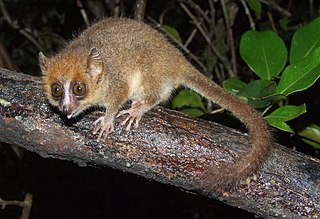
The pygmy mouse lemur, also known as Peters' mouse lemur or dormouse lemur, is a primate weighing only 43–55 g (1.5–1.9 oz); it is the second smallest of the mouse lemurs. Its dorsal side is a rufous-brown colour, and creamy-white ventrally. It lives in dry deciduous forests of western Madagascar. It has been captured in the Tsingy de Bemaraha Nature Reserve, the Andramasy forests north of Belo sur Tsiribihina, and the border of heavily degraded deciduous forest and savanna at Aboalimena. It has also been found in other habitats, in mangroves in two localities.

The golden-brown mouse lemur, also known as the (Lac) Ravelobe mouse lemur, is part of the Cheirogaleidae family, and the smallest species of lemur. It is arboreal, nocturnal and usually social. It get its name from the color of its body. Like several other mouse lemurs, like the brown mouse lemur, it is a small primate that has a brown dorsal side and a whitish-grey for its ventral side of the body. All lemurs live in Madagascar. This species was discovered in 1994.
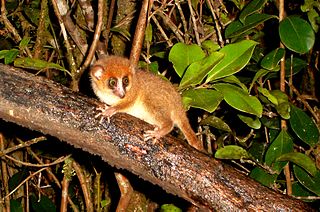
The brown mouse lemur is a small primate, and like the other mouse lemurs can only be found on the island of Madagascar. They are known also as the rufous mouse lemur, eastern rufous mouse lemur, red mouse lemur, or russet mouse lemur. Its dorsal side is brown or reddish-brown, while ventrally it is a whitish-grey.

The northern giant mouse lemur, or northern dwarf lemur, is a species of lemur discovered in 2005. They are part of the primate order, and classified in the family Cheirogaleidae. Previously, both populations of giant mouse lemurs were believed to belong to one species. The northern giant mouse lemurs are small nocturnal lemurs endemic to Madagascar. They weigh about 300 grams (11 oz), and have long, bushy tails and relatively small ears. Their large testicles are an indication of their promiscuous copulation system. These lemurs have been found to use communal sleeping nests including multiple males, which is an uncommon behaviour in lemurs.

Jolly's mouse lemur is a species of mouse lemur from Mananjary and Kianjavato in Madagascar. The species is named in honor of primatologist Alison Jolly.
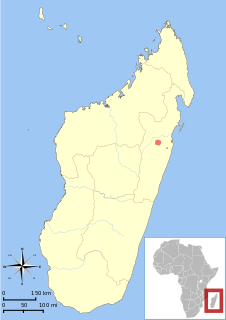
Simmons' mouse lemur is a species of mouse lemur known only from Betampona Special Reserve, Analalava Special Community Reserve near Foulpointe, and Zahamena National Park in Madagascar.
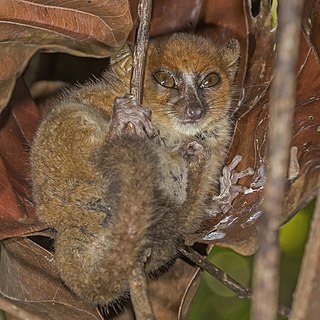
Claire's mouse lemur, or the Nosy Be mouse lemur, is a newly described species of lemur from the genus of the mouse lemurs (Microcebus). It lives on the island Nosy Bé in the Antsiranana province of Madagascar, and on the mainland near the village of Manehoka, including Lokobe Reserve. The scientific type name, mamiratra, comes from Malagasy and means "clear and bright"; this refers the Theodore F. and Claire M. Hubbard Family Foundation, which has contributed to genetic research on Madagascar. This species is closely related to another new species, "M. species nova # 5"; which is related to the Sambirano mouse lemur, Microcebus sambiranensis, and the northern rufous mouse lemur, Microcebus tavaratra.
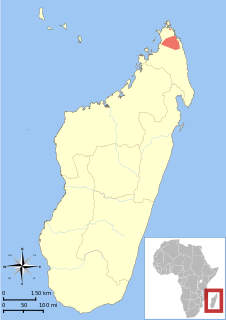
The northern rufous mouse lemur, northern brown mouse lemur, or Tavaratra mouse lemur is found in Northern Madagascar from the Ankarana National Park in the West to the river Manambato in Northeast and up to the Irodo river in the North of the Analamerana Special Reserve. The complete distribution range of M. tavaratra is still to be defined as some areas surrounding the described distribution have not been visited yet. For example, M.tavaratra has been reported to possibly occur from the Irodo up to the Montagne des Francais by Louis and collaborators in. Its known distribution cover four protected areas the Ankarana National Park, and the Analamerana Special Reserve both managed by Madagascar National Parks, the Loky-Manambato Region (Daraina) and the Andavakoeira-Andrafiamena protected area, both Managed by the NGO Fanamby

The reddish-gray mouse lemur also known as the gray-brown mouse lemur or rufous-gray mouse lemur, is found in Western Madagascar in the region around Beza Mahafaly Reserve, north to Lamboharana.

Madame Berthe's mouse lemur or Berthe's mouse lemur is the smallest of the mouse lemurs and the smallest primate in the world; the average body length is 9.2 cm (3.6 in) and seasonal weight is around 30 g (1.1 oz). Microcebus berthae is one of many species of Malagasy lemurs that came about through extensive speciation, caused by unknown environmental mechanisms and conditions.

The mouse lemurs are nocturnal lemurs of the genus Microcebus. Like all lemurs, mouse lemurs are native to Madagascar.
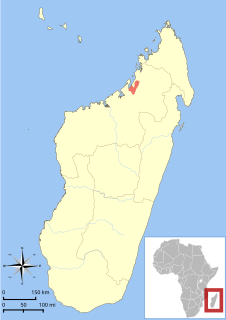
Danfoss's mouse lemur, or the Ambarijeby mouse lemur, is a species of mouse lemur endemic to Madagascar. It lives in western deciduous forest within a limited range between the Sofia River and the Maevarano River. It is a relatively large reddish mouse lemur with a total length of 25 to 29 centimeters, including 15 to 17 centimeters of tail. The Danfoss' mouse lemur has short, dense fur, and a white stripe runs between the eyes. This species has been found in substantial populations in the Ambarijevy, Anjajavy, and Beanamaolo forests in Madagascar.
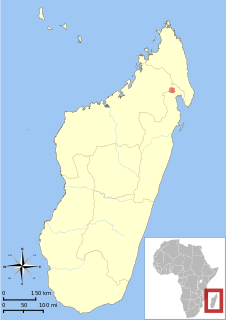
MacArthur's mouse lemur, or the Anjiahely mouse lemur, is a species of mouse lemur known only from Makira Natural Park in northeastern Madagascar.

Arnhold's mouse lemur or the Montagne d'Ambre mouse lemur is a species of mouse lemur endemic to Madagascar. Its holotype was first collected on 27 November 2005, and was first described in 2008. According to genetic tests, it is genetically distinct from its closest sister taxa, the Sambirano mouse lemur.

Margot Marsh's mouse lemur or the Antafondro mouse lemur is a species of mouse lemur endemic to Madagascar. Its holotype was first collected on 21 May 2006, proposed in 2006 by Andriantompohavana et al., and was formally described in 2008 by E. Lewis, Jr., et al. According to genetic tests, it is genetically distinct from its closest sister taxon, Claire's mouse lemur.

The Marohita mouse lemur is a species of mouse lemur known only from the Marohita Forest in eastern Madagascar, near the village of Marolambo. Specimens were first collected in December 2003, and its discovery was announced in 2013 along with the Anosy mouse lemur. It is a large mouse lemur, weighing up to 89 g (3.1 oz), and lives within the same area as the Goodman's mouse lemur (M. lehilahytsara), Simmons' mouse lemur (M. simmonsi), and the brown mouse lemur (M. rufus), all four of which are nearly identical in appearance. Its fur is rufous on its back and grayish-beige on its underside. Nothing is known about its behavior. Its conservation status was evaluated as Endangered by the International Union for Conservation of Nature (IUCN) in 2012, before it was formally described, because its only known habitat had severely degraded between 2003 and 2012.
The Bemanasy mouse lemur, Microcebus manitatra, is a species of mouse lemur described in 2016 from Madagascar. It was discovered by a team of researchers at the German Primate Center. It was initially discovered among closely related species such as Madame Berthe's mouse lemur, Boraha mouse lemur, and Ganzhorn's mouse lemur. Morphological similarity made it impossible to identify them as distinct species. A genetic study was done in collaboration with scientists at the University of Kentucky, the Duke Lemur Center and the University of Antananarivo in Madagascar. The mtDNA sequencing revealed that the species was unique.

















